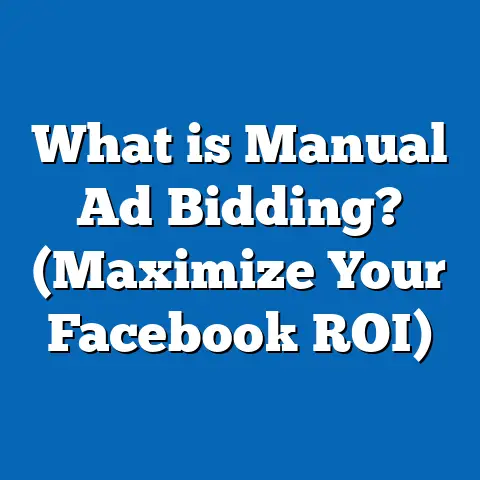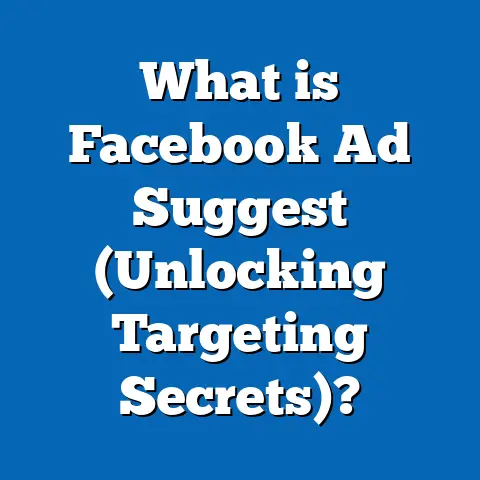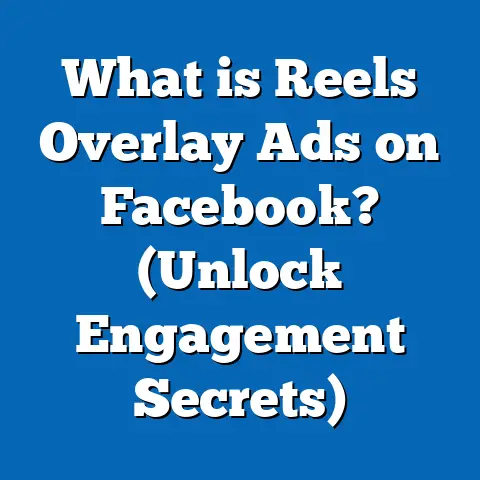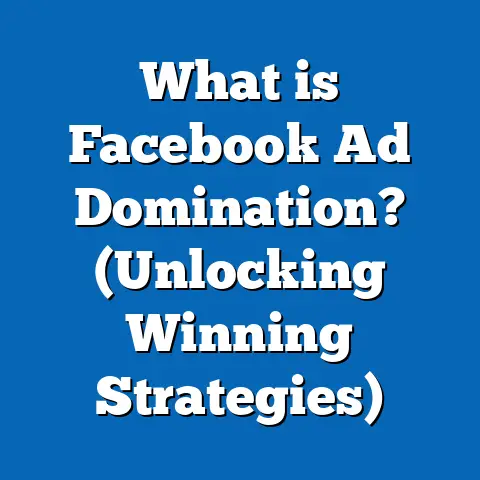What is the Best Campaign Bid Strategy for Facebook Ads? (Unlock ROI Secrets)
Introduction: The Surprising Power of Facebook Ads Bid Strategies
Did you know that over 2.9 million advertisers compete daily on Facebook’s ad platform? This vast competition creates a fiercely competitive auction environment where every bid matters. While many marketers focus heavily on creative content or audience targeting, one critical factor often remains underestimated: the bid strategy.
Choosing the right bid strategy is not about simply spending less on ads; it’s about spending smarter to maximize your return on investment (ROI). The bid strategy determines how Facebook’s auction system prioritizes your ads and how much you pay per result. When optimized, it can dramatically improve campaign efficiency, lower costs per conversion, and increase revenue.
Section 1: Understanding Facebook Ads Bid Strategy
What Is a Bid Strategy?
A bid strategy is the method you choose to instruct Facebook on how to spend your advertising budget during auctions. It tells the system how aggressively or cautiously to bid on your behalf to get the best possible results based on your campaign objectives.
Importance of Bid Strategy in Facebook Ads
Facebook uses an auction system where advertisers compete to show their ads to targeted users. The bid strategy directly impacts:
- Cost per Result: How much you pay for each click, lead, or conversion.
- Ad Delivery: When and how often Facebook shows your ads.
- Return on Investment (ROI): Efficient bidding can reduce costs and boost profitability.
By selecting the right bid strategy, you can influence how Facebook’s algorithm balances cost with ad delivery volume and quality.
Core Auction Components Affecting Bid Strategy
Understanding Facebook’s auction is key:
- Bid Amount: The maximum you’re willing to pay for an action.
- Estimated Action Rate: Facebook’s prediction of how likely the targeted user will complete your desired action.
- Ad Quality: Measured by relevance diagnostics such as engagement rates and feedback.
Facebook assigns a Total Value score to each ad by multiplying its estimated action rate by the bid and factoring in ad quality. The highest total value wins the auction—not necessarily the highest bid.
Section 2: Detailed Breakdown of Facebook Ad Bid Strategies
Facebook provides several bid strategies designed to meet different advertiser needs and objectives. These include:
1. Lowest Cost (Automatic Bidding)
What It Is
This is Facebook’s default bidding option where the platform automatically bids the lowest amount necessary to get you results while spending your budget.
How It Works
Facebook optimizes bids to maximize conversions or actions without exceeding your total budget. It aims to get the most results at the lowest possible cost per result.
Use Cases
- Beginners new to Facebook ads.
- Campaigns focused on maximizing volume (e.g., brand awareness).
- Flexible budgets where CPA fluctuations are acceptable.
Advantages
- Simplifies campaign management.
- Maximizes ad impressions and conversions.
- Requires minimal manual adjustments.
Drawbacks
- Cost per result can fluctuate due to competition.
- May lead to overspending during peak competition times.
- Less control over individual bid amounts.
2. Cost Cap Bidding
What It Is
Cost Cap bidding allows you to set an average target cost per result that Facebook should maintain or stay below while maximizing results within that limit.
How It Works
Facebook dynamically adjusts bids but ensures that your average cost per conversion does not exceed the cost cap over time.
Use Cases
- Advertisers with strict ROI targets.
- Businesses needing consistent CPA for budgeting.
- Scaling campaigns while maintaining cost-efficiency.
Advantages
- Balances cost control with volume.
- Keeps CPA stable despite competition changes.
- Ideal for campaigns with tight profit margins.
Drawbacks
- Setting the cost cap too low may limit ad delivery.
- Requires monitoring and adjustment as market dynamics change.
3. Bid Cap Bidding (Manual Bidding)
What It Is
Bid Cap lets you set a maximum bid amount for each auction, preventing Facebook from bidding higher than your specified limit.
How It Works
Facebook bids up to your maximum limit but never exceeds it, giving you direct control over how much you pay per auction.
Use Cases
- Advertisers with strict maximum cost thresholds.
- Campaigns targeting highly competitive audiences.
- Situations where budget discipline is critical.
Advantages
- Tight control over maximum bid price.
- Prevents overspending in high-demand auctions.
Drawbacks
- Can severely restrict ad delivery and volume.
- Risk of losing auctions to competitors with higher bids.
- Requires manual fine-tuning and monitoring.
4. Target Cost (Legacy Option)
Facebook has deprecated Target Cost bidding but some advertisers still use it. It aimed for consistent CPA but has been replaced largely by Cost Cap bidding due to better performance stability with the latter.
Section 3: Data-Backed Insights into Bid Strategy Performance
Industry Benchmarks on Facebook Ad Bid Strategies
Data from WordStream’s 2024 report highlights key performance differences between strategies:
| Bid Strategy | Average CPC | Average CPA | Conversion Rate |
|---|---|---|---|
| Lowest Cost | $0.45 | $18.50 | 3.5% |
| Cost Cap | $0.50 | $15.00 | 4.0% |
| Bid Cap | $0.55 | $14.00 | 3.8% |
What This Data Tells Us
- Cost Cap bidding maintains a better balance between cost and volume.
- Bid Cap gives tight cost control but may reduce scale.
- Lowest Cost delivers volume but with less predictable CPAs.
Real World Case Study: E-commerce Brand Using Cost Cap
A cosmetics e-commerce brand switched from Lowest Cost to Cost Cap bidding for their conversion campaigns over three months:
| Metric | Before (Lowest Cost) | After (Cost Cap) |
|---|---|---|
| CPA | $20 | $14 |
| Return on Ad Spend (ROAS) | 3x | 4.5x |
| Conversion Volume | Stable | Stable |
The switch allowed tighter control over CPA without sacrificing conversions, improving profitability significantly.
Section 4: How Facebook’s Auction System Works With Bid Strategies
Detailed Auction Mechanics
Facebook’s auction isn’t just about bidding high; it balances bid amount with predicted user action and ad quality: Total Value=Estimated Action Rate×Bid+Ad Quality Score\text{Total Value} = \text{Estimated Action Rate} \times \text{Bid} + \text{Ad Quality Score}
This means:
- A lower bid with a highly relevant ad may win over a higher bid with poor relevance.
- Effective bid strategies work alongside excellent targeting and creative quality.
Why Bid Strategy Alone Isn’t Enough
Even if you pick the optimal bid strategy, poor audience targeting or weak ad creatives can increase costs or reduce conversions. Bid strategy optimization should be part of a holistic campaign approach involving:
- Precise audience segmentation
- High-quality, engaging creatives
- Proper campaign objectives setting
- Continuous monitoring and optimization
Section 5: Choosing the Right Bid Strategy — A Step-by-Step Guide
Step 1: Define Clear Campaign Objectives
Common objectives include:
- Awareness (reach or impressions)
- Traffic (website clicks)
- Lead generation
- Sales/conversions
- App installs
Each objective aligns better with specific bid strategies.
Step 2: Assess Your Budget and Flexibility
- Small budgets often benefit from Lowest Cost for maximum reach.
- Medium or larger budgets aiming for profitability should consider Cost Cap.
- If cost per acquisition must never exceed a threshold, use Bid Cap cautiously.
Step 3: Test Multiple Bid Strategies Side-by-Side (A/B Testing)
Run experiments comparing Lowest Cost vs Cost Cap:
- Set identical audience and creatives.
- Measure CPA, ROAS, volume over at least two weeks.
- Choose strategy that meets your financial goals without sacrificing scale.
Step 4: Monitor Performance Metrics Closely
Track:
- Cost per result/conversion
- Conversion volume
- Frequency and CTR
- ROAS and profit margins
Adjust bids or caps based on real-time data.
Section 6: Advanced Tips & Techniques for Maximizing ROI with Bid Strategies
Use Campaign Budget Optimization (CBO)
CBO allows Facebook to allocate budget across multiple ad sets dynamically based on performance signals combined with your bid strategy.
Benefits include:
- Better budget distribution
- Improved overall campaign ROI
- Easier management for complex campaigns
CBO works well especially when paired with Cost Cap bidding for consistent cost control across segments.
Leverage Value-Based Bidding
For businesses with varying purchase values (e.g., e-commerce stores):
- Upload customer value data into Facebook.
- Use value-based optimization to prioritize higher-value conversions.
- Combine with Cost Cap bidding focused on average ROAS targets.
This ensures budget goes where it matters most financially, not just volume.
Monitor Frequency & Creative Fatigue
Even the best bid strategy can’t fix ad fatigue. High frequency leads to lower engagement and higher costs. Best practices include:
- Rotate creatives every 1–2 weeks
- Refresh offers or messaging regularly
- Use video and interactive formats for engagement boosts
Retargeting Campaigns & Bid Strategies
For retargeting warm audiences:
- Consider tighter CPA goals with Cost Cap or Bid Cap.
- Focus on ROAS rather than just volume.
- Use custom audiences segmented by engagement level for precise bidding.
Section 7: Comparison With Other Advertising Platforms’ Bidding Models
| Platform | Bid Strategy Options | Key Characteristics |
|---|---|---|
| Google Ads | Manual CPC, Enhanced CPC, Target ROAS | Granular control; keyword-level bidding |
| LinkedIn Ads | Automated bids, Maximize clicks, Target cost | Professional audience; higher CPC |
| TikTok Ads | Lowest cost, Cost cap, Bid cap | Similar structure; younger demographic |
Insight: While all platforms use auction-based bidding, Facebook’s extensive audience data and machine learning give it unique flexibility in balancing bid strategies with ad relevancy signals.
Section 8: Practical Examples & Real-Life Application of Bid Strategies
Example 1: Local Fitness Studio Running Awareness Campaign
Goal: Increase class sign-ups
Budget: $800/month
Bid Strategy: Lowest Cost
Outcome: High reach and CTR; sign-ups increased by 20%. Costs fluctuated but remained within budget.
Example 2: SaaS Company Driving Trial Signups With ROI Constraints
Goal: Maximize free trial sign-ups at <$10 CPA
Budget: $6,000/month
Bid Strategy: Cost Cap at $10 CPA
Outcome: Consistent CPAs, scalable sign-ups increased 30%, improved downstream conversion rates to paid customers.
Example 3: E-commerce Store Launching New Product Line With Tight Budget Control
Goal: Drive sales at <$15 CPA
Budget: $2,000/month
Bid Strategy: Bid Cap at $15
Outcome: Delivery limited initially; after increasing cap slightly, volume improved while maintaining CPA targets.
Section 9: Latest Trends & Updates in Facebook Ad Bidding (2024)
AI-Powered Real-Time Bidding Enhancements
Facebook increasingly uses AI to adjust bids dynamically during auctions based on real-time data signals like user behavior shifts and competitor activity.
Shift from Target Cost to Cost Cap Bidding
Advertisers are recommended to phase out Target Cost in favor of Cost Cap for better cost predictability and scale.
Conversion API Integration Impact
Improved data tracking through Conversion API allows more accurate attribution leading to smarter bid optimization and better CPA results.
Greater Emphasis on Value-Based Bidding in E-commerce
As advertisers gather richer customer value data, Facebook encourages shifting from simple conversions to value-focused bidding strategies for maximizing lifetime customer value.
Section 10: Common Pitfalls & How to Avoid Them in Bid Strategy Selection
- Setting Unrealistic Cost Caps or Bids
Too low caps restrict delivery; too high lose cost control. Start realistic based on historical data and adjust gradually.
- Ignoring Audience Quality
No bid strategy fixes poor targeting or irrelevant audiences. Invest in audience research and segmentation first.
- Neglecting Creative Quality
Low-quality ads increase costs regardless of bidding method. Always test creative variants and monitor engagement metrics.
- Failing to Monitor & Optimize
Bid strategies require ongoing monitoring; don’t “set it and forget it.” Use data-driven adjustments weekly or biweekly.
- Over-focusing on Low CPC Instead of ROI
Low CPC doesn’t always translate to profitable conversions—focus on cost per acquisition and return metrics instead.
Section 11: Summary – Key Takeaways & Next Steps for Marketers and Business Owners
- Bid strategy is critical for controlling ad costs and maximizing ROI in Facebook Ads.
- Lowest Cost bidding suits beginners and campaigns focused on volume without strict CPA limits.
- Cost Cap bidding offers a strong balance of scale and cost control ideal for most advertisers focused on ROI.
- Bid Cap bidding provides tight cost control but can limit delivery if set too low.
- Always combine bid strategies with high-quality creatives, precise targeting, and continuous testing.
- Use tools like Campaign Budget Optimization (CBO) and value-based bidding to enhance performance further.
- Stay updated on platform changes such as AI-driven bidding improvements and Conversion API integration.
- Test systematically using A/B tests comparing strategies based on your business goals.
Appendices & Resources
Appendix A: Glossary of Key Terms
| Term | Definition |
|---|---|
| CPA | Cost Per Acquisition/Action |
| CPC | Cost Per Click |
| ROAS | Return on Ad Spend |
| CBO | Campaign Budget Optimization |
| Conversion API | Server-side tracking method |
| Estimated Action Rate | Facebook’s predicted likelihood of action |
Appendix B: Sample Campaign Setup for Testing Bid Strategies
| Step | Action |
|---|---|
| Objective | Conversions |
| Audience | Lookalike + interest-based segment |
| Creative | Video + carousel ads |
| Budget | $100/day |
| Test Groups | Group A: Lowest Cost; Group B: Cost Cap |
| Duration | Minimum 14 days |
| Metrics | CPA, conversion volume, ROAS |
If you want me to provide specific campaign templates or further case studies tailored for your industry or budget size, just ask!





